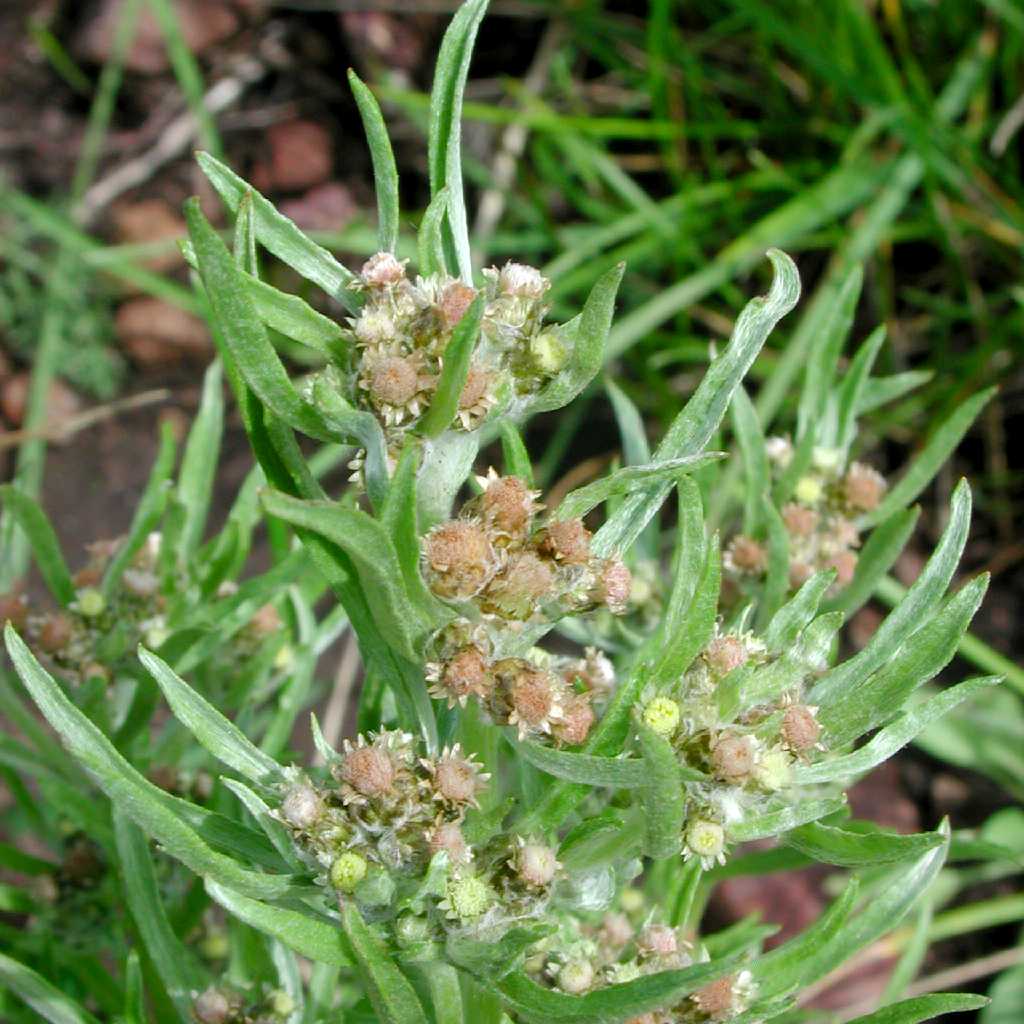
|
Family: Asteraceae |
Annuals [biennials or perennials], (1-)3-30 cm; usually taprooted, sometimes fibrous-rooted. Stems usually 1, erect (often with decumbent-ascending branches from bases; ± woolly-tomentose, not glandular). Leaves mostly cauline; alternate; ± sessile; blades oblanceolate to spatulate or linear, bases ± cuneate, margins entire, faces concolor, gray and tomentose. Heads disciform, usually in ± capitate clusters (in axils of leaves or bracts), sometimes in spiciform glomerules. Involucres narrowly to broadly campanulate, 2.5-4 mm. Phyllaries in 3-5 series, usually white or tawny to brown (opaque or hyaline, often shiny; stereomes usually glandular distally), ± equal to unequal, chartaceous toward tips (inner phyllaries narrowly oblong, usually white-tipped and protruding distal to outer). Receptacles flat, smooth, epaleate. Peripheral (pistillate) florets 40-80 (more numerous than bisexual); corollas purplish or whitish. Inner (bisexual) florets 4-7; corollas purplish or whitish. Cypselae oblong, faces usually glabrous, sometimes minutely papillate (hairs ± papilliform, not myxogenic); pappi readily falling, of 8-12 distinct, barbellate bristles in 1 series. x = 7. Generic segregations have reduced Gnaphalium from hundreds of species to ca. 38. North American species (north of Mexico) not included here have been segregated to Euchiton, Gamochaeta, Omalotheca, and Pseudognaphalium. Species of Gnaphalium in the strict sense (adopted here) are usually ca. 3-30 cm, loosely tomentose and not glandular, and have loosely glomerulate heads, involucres 2-3(-4) mm diam., white-tipped inner phyllaries, papillate cypselae, and readily falling pappi of distinct bristles, features especially contrasting with Pseudognaphalium, to which most North American species have been transferred. Because of their relatively small stature and tendency to produce loosely spiciform arrays of heads, gnaphaliums sometimes are identified as gamochaetas, which have different cypselar vestitures and different pappi. The lectotype species of Gnaphalium is G. uliginosum Linnaeus; discussion of this choice rather than Pseudognaphalium (Gnaphalium) luteoalbum (Linnaeus) Hilliard & Burtt is given in C. Jeffrey (1979), O. M. Hilliard and B. L. Burtt (1981), and J. McNeill et al. (1987). Gnaphalium polycaulon Persoon is included in the key because it probably will be found in warmer coastal localities in the United States (perhaps Florida or California). It is a cosmopolitan weed (Old World native) and occurs in Mexico. It has sometimes been identified by the misapplied name Gnaphalium indicum Linnaeus.
Heads disciform, yellow or whitish, the numerous outer fls pistillate, with tubular-filiform cor about equaling the pappus, the few inner ones coarser and perfect; invol ovoid or campanulate, its bracts ±imbricate, scarious at least at the tip; receptacle flat to subconic, naked; anthers caudate; style-branches slender, minutely papillate outside, slightly flattened, with ventromarginal stigmatic lines extending to the truncate or slightly expanded tip; achenes small, terete or slightly compressed, nerveless; pappus of capillary bristles, these sometimes thickened at the summit, sometimes connate at the base; woolly herbs with alternate, entire lvs. (Gamochaeta) 100+, cosmop. Gleason, Henry A. & Cronquist, Arthur J. 1991. Manual of vascular plants of northeastern United States and adjacent Canada. lxxv + 910 pp. ©The New York Botanical Garden. All rights reserved. Used by permission. |
This project was made possible in part by the Institute of Museum and Library Services [MG-70-19-0057-19].
Powered by Symbiota



